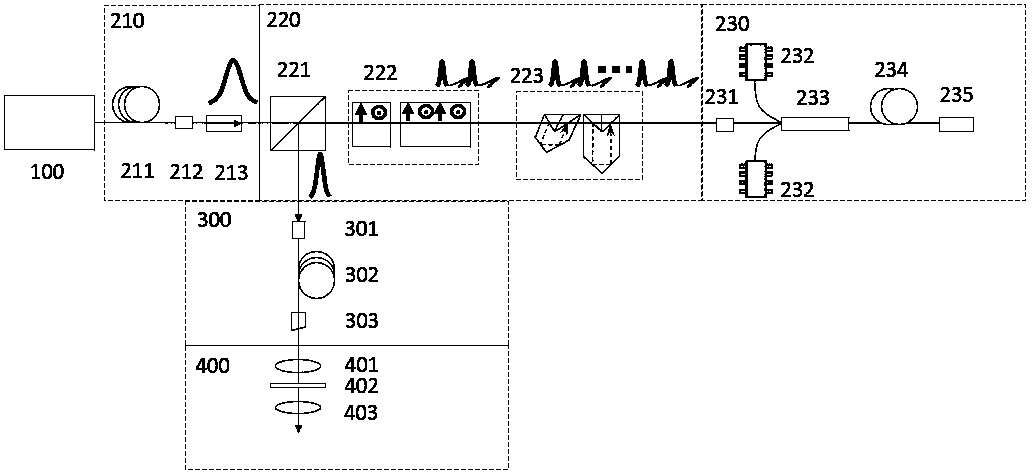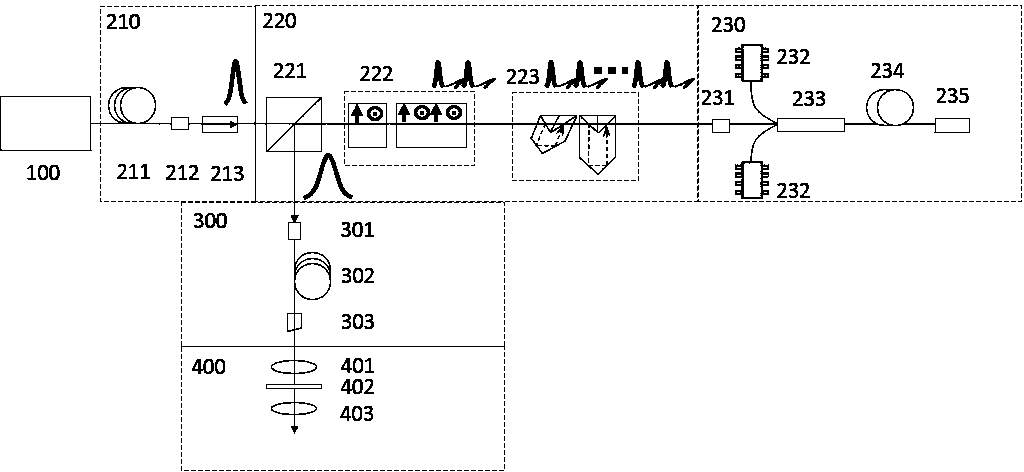780 nm high-power optical-fiber femtosecond laser device
A technology of femtosecond lasers and lasers, applied in the direction of lasers, laser components, phonon exciters, etc., can solve the problems of reducing the quality and difficulty of pulse compression, and achieve the reduction of nonlinear effects, reduction of welding and coupling losses, and high quality The effect of pulse compression on
- Summary
- Abstract
- Description
- Claims
- Application Information
AI Technical Summary
Problems solved by technology
Method used
Image
Examples
Embodiment 1
[0039] refer to figure 2 , which is a 780 nm high-power fiber femtosecond laser of the present invention with a positive chirped collinear yttrium avanate and a polarization beam-splitting cube hybrid pulse stretching method.
[0040] The femtosecond pulse output by the erbium-doped fiber laser oscillator stage 100 is stretched to 1 ps by the dispersion compensating fiber 211 whose second-order dispersion is positive at 1560nm, and then the pulse is output by the fiber collimator 212 and passed through a 1560nm spatial optical isolator 213 is used to protect the seed light. The laser passes through a polarization beam splitting cube 221 to obtain linearly polarized laser light. The resulting linearly polarized laser pulses pass through a collinear pulse splitting device 222 based on yttrium aluminate crystals. Since the optical axis of the yttrium vanamate crystal is parallel to the interface, and the included angle with the polarization direction of the incident light is 4...
Embodiment 2
[0042] refer to image 3 , which is a 780 nm high-power fiber-excited second optical device of the present invention with a negative chirped collinear yttrium avanate and a polarization beam-splitting cube hybrid pulse stretching method.
[0043] The femtosecond pulse output by the erbium-doped fiber laser oscillator stage 100 is stretched to 1 ps by the single-mode fiber 211 whose second-order dispersion is negative at 1560nm, and then the pulse is output by the fiber collimator 212 and passed through a 1560nm spatial optical isolator 213 is used to protect the seed light. The laser passes through a polarization beam splitting cube 221 to obtain linearly polarized laser light. The resulting linearly polarized laser pulses are separated 222 by collinear pulses based on yttrium aluminate crystals. Since the optical axis of the yttrium aluminate crystal is parallel to the interface, and the angle with the polarization direction of the incident light is 45°, each pulse is s...
Embodiment 3
[0045] refer to Figure 4 , which is a 780 nm high-power fiber femtosecond laser of the present invention with a positive chirped non-collinear yttrium avanate and a polarization beam-splitting cube hybrid pulse stretching method.
[0046] The femtosecond pulse output by the erbium-doped fiber laser oscillator stage 100 is stretched to 1 ps by the dispersion compensating fiber 211 whose second-order dispersion is positive at 1560nm, and then the pulse is output by the fiber collimator 212 and passed through a 1560nm spatial optical isolator 213 is used to protect the seed light. The laser passes through a polarization beam splitting cube 221 to obtain linearly polarized laser light. The resulting linearly polarized laser pulses are separated 222 by collinear pulses based on yttrium aluminate crystals. Since the optical axis of the yttrium aluminate crystal is parallel to the interface, and the angle between the interface and the interface is 45°, each pulse is separated ...
PUM
 Login to View More
Login to View More Abstract
Description
Claims
Application Information
 Login to View More
Login to View More - R&D
- Intellectual Property
- Life Sciences
- Materials
- Tech Scout
- Unparalleled Data Quality
- Higher Quality Content
- 60% Fewer Hallucinations
Browse by: Latest US Patents, China's latest patents, Technical Efficacy Thesaurus, Application Domain, Technology Topic, Popular Technical Reports.
© 2025 PatSnap. All rights reserved.Legal|Privacy policy|Modern Slavery Act Transparency Statement|Sitemap|About US| Contact US: help@patsnap.com



